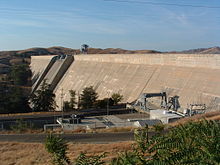Friant Dam
| Friant Dam | |
|---|---|
 |
|
| Country | United States |
| Location | Madera/Fresno Counties, California |
| Coordinates | 37°00′02″N 119°42′19″W / 37.00056°N 119.70528°WCoordinates: 37°00′02″N 119°42′19″W / 37.00056°N 119.70528°W |
| Construction began | 1939 |
| Opening date | 1942 |
| Owner(s) | Central Valley Project |
| Dam and spillways | |
| Type of dam | Concrete gravity |
| Impounds | San Joaquin River |
| Height | 319 ft (97 m) |
| Length | 3,488 ft (1,063 m) |
| Width (base) | 267 ft (81 m) |
| Spillway type | Gated overflow, 3x flotation drum gates |
| Spillway capacity | 83,000 cu ft/s (2,400 m3/s) |
| Reservoir | |
| Creates | Millerton Lake |
| Total capacity | 520,528 acre·ft (642,062 dam3) |
| Inactive capacity | 120,000 acre·ft (150,000 dam3) |
| Catchment area | 1,638 sq mi (4,240 km2) |
| Surface area | 4,900 acres (2,000 ha) |
| Power station | |
| Turbines | 1x 15 MW, 1x 8 MW, 1x 2 MW |
| Installed capacity | 25 MW |
| Annual generation | 81,409,000 KWh |
Friant Dam is a concrete gravity dam on the San Joaquin River in central California in the United States, on the boundary of Fresno and Madera Counties. It was built between 1937 and 1942 as part of a U.S. Bureau of Reclamation (USBR) water project to provide irrigation water to the southern San Joaquin Valley. The dam impounds Millerton Lake, a 4,900-acre (2,000 ha) reservoir about 15 miles (24 km) north of Fresno.
The valley in which Friant Dam and Millerton Lake now lie was once the location of the historic town of Millerton. Millerton was the first county seat of Fresno County. In 1880, the first dam on the San Joaquin River was constructed by the Upper San Joaquin Irrigation Company roughly on the present site of Friant Dam. Built of local rock, the dam was an 800-foot (240 m) long, 6-foot (1.8 m) tall structure designed to divert water for the irrigation of 250,000 acres (100,000 ha). The project was abandoned in the wake of floods that destroyed the dam two years later.
Friant Dam was originally proposed in the 1930s as a main feature of the Central Valley Project (CVP), a federal water project that would involve building an expansive system of dams and canals on the rivers of the Central Valley to provide water for agriculture, with secondary purposes of flood control, municipal supply, and hydroelectric power generation. The CVP was authorized by the 1935 Rivers and Harbors Act, while $20 million of initial funding for Friant Dam was provided by the Emergency Relief Appropriation Act of 1935.
Initial surveys of the Friant Dam site were carried out in November 1935 and continued through early 1936. In January 1938, a worker's camp was established near the town of Friant to house the laborers that would ultimately work on the dam. In the middle of the Great Depression, the Friant Dam site saw a huge influx of job seekers, many of whom had to live further away in surrounding cities. More than 50,000 people attended the groundbreaking of the dam on November 5, 1939 in a celebration that is now known as "one of the greatest in San Joaquin Valley history".
...
Wikipedia
